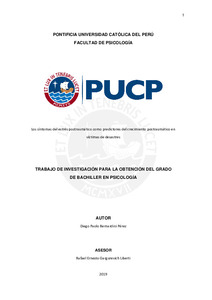| dc.contributor.advisor | Gargurevich Liberti, Rafael Ernesto | |
| dc.contributor.author | Bernardini Pérez, Diego Paolo | |
| dc.date.accessioned | 2021-02-18T20:49:24Z | |
| dc.date.available | 2021-02-18T20:49:24Z | |
| dc.date.created | 2019 | |
| dc.date.issued | 2021-02-18 | |
| dc.identifier.uri | http://hdl.handle.net/20.500.12404/18275 | |
| dc.description.abstract | Los desastres son entendidos como eventos potencialmente traumáticos, capaces de generar en
las personas sintomatología preocupante como la del trastorno de estrés postraumático (SEPT),
pero, también, una serie de cambios psicológicos beneficiosos como el crecimiento
postraumático (CPT) o en la gran mayoría de los casos, ambos (Manzoor & Ali, 2018;
Schulenberg, 2016; Tedeschi & Calhoun, 1996). El objetivo del presente estudio fue determinar
si la sintomatología postraumática (SEPT) era un predictor positivo del CPT y sus dimensiones
en adultos víctimas de desastres en Lima. De este modo, se contó con una muestra de 290
personas, compuesta por víctimas del Fenómeno del Niño del año 2017 y víctimas del aniego
ocurrido en el distrito de San Juan de Lurigancho el año 2019. A dicha muestra se le aplicó el
Inventario de Crecimiento Postraumático (Tedeschi & Calhoun, 1996) y el Posttraumatic Stress
Disorder Checklist (Weathers et al., 2013). Las regresiones lineales jerárquicas denotaron que
la sintomatología postraumática, y en específico los síntomas de intrusión y evitación, son
predictores significativos del CPT posterior a los desastres. Los resultados vinculados a la
predicción de la sintomatología respecto a las dimensiones del CPT se discutirán con mayor
profundidad en el documento. Se concluye que el experimentar cierto nivel de estrés
psicológico sería clave para el subsecuente desarrollo del CPT, lo cual pone de relieve la
importancia de diseñar intervenciones post desastre que no solo busquen mitigar los posibles
síntomas desadaptativos, sino promover el crecimiento en diferentes ámbitos de la vida de la
persona. | es_ES |
| dc.description.abstract | Disasters are understood as potentially traumatic events, capable of generating worrying
symptoms in people such as posttraumatic stress disorder (PTSD), but also a series of beneficial
psychological changes such as posttraumatic growth (PTG) or in the vast majority of cases,
both (Manzoor & Ali, 2018; Schulenberg, 2016; Tedeschi & Calhoun, 1996). The aim of this
study was to determine if post-traumatic symptomatology (PTSS) was a positive predictor of
PTG and its dimensions in adult victims of disasters in Lima. In this way, the sample consisted
of 290 people, composed of victims of the “Fenómeno del Niño” of 2017 and victims of the
flooding occurred in the district of San Juan de Lurigancho in 2019. The Posttraumatic Growth
Inventory (Tedeschi & Calhoun, 1996) and the Posttraumatic Stress Disorder Checklist
(Weathers et al., 2013) was completed by the participants. Hierarchical linear regressions
denoted that PTSS, and specifically intrusion and avoidance symptoms, are significant
predictors of post-disaster PTG. The results linked to the prediction of the symptomatology
regarding the dimensions of the CPT will be discussed in greater depth in the document. It is
concluded that experiencing a certain level of psychological stress would be important for the
subsequent development of the CPT on disasters victims, which highlights the importance of
designing post-disaster interventions that not only seek to mitigate possible maladaptive
symptoms, but also promote growth in different areas of life of the person. | es_ES |
| dc.language.iso | spa | es_ES |
| dc.publisher | Pontificia Universidad Católica del Perú | es_ES |
| dc.rights | info:eu-repo/semantics/openAccess | es_ES |
| dc.rights.uri | http://creativecommons.org/licenses/by/2.5/pe/ | * |
| dc.subject | Trastorno por stress postraumático | es_ES |
| dc.subject | Desastres--Perú | es_ES |
| dc.title | Los síntomas del estrés postraumático como predictores del crecimiento postraumático en víctimas de desastres | es_ES |
| dc.type | info:eu-repo/semantics/bachelorThesis | es_ES |
| thesis.degree.name | Bachiller en Psicología | es_ES |
| thesis.degree.level | Bachillerato | es_ES |
| thesis.degree.grantor | Pontificia Universidad Católica del Perú. Facultad de Psicología | es_ES |
| thesis.degree.discipline | Psicología | es_ES |
| renati.advisor.dni | 9338900 | |
| renati.advisor.orcid | https://orcid.org/0000-0001-6346-4134 | es_ES |
| renati.author.dni | 72643527 | |
| renati.discipline | 313016 | es_ES |
| renati.level | https://purl.org/pe-repo/renati/level#bachiller | es_ES |
| renati.type | https://purl.org/pe-repo/renati/type#trabajoDeInvestigacion | es_ES |
| dc.publisher.country | PE | es_ES |
| dc.subject.ocde | http://purl.org/pe-repo/ocde/ford#5.01.00 | es_ES |






